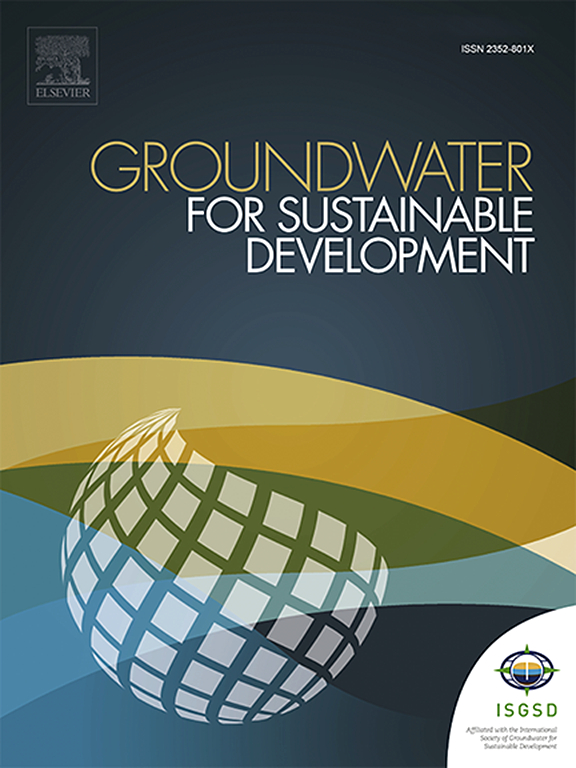Machine-learning based spatiotemporal performance analysis of degraded tropical peatland groundwater level numerical model
IF 4.9
Q2 ENGINEERING, ENVIRONMENTAL
引用次数: 0
Abstract
In this study, we used a numerical model, MODFLOW, to simulate groundwater level fluctuations and estimate saturated hydraulic conductivity (Ks) of peat structure in a degraded environment in Central Kalimantan, Indonesia. The model was calibrated and validated using groundwater level data manually collected at 265 dipwells on a monthly basis from 2011 to 2019; the parameterized model produced Nash–Sutcliffe Efficiency coefficients of 0.97 and 0.95 for calibration and validation, respectively. We also employed machine learning algorithms to investigate sources of spatiotemporal errors produced by the calibrated model. Extreme gradient boosting (XGBoost) algorithm with R2 of 0.99 and RMSE of 0.05m outperformed random forest (RF) algorithm in predicting actual residuals. Model performance for estimating groundwater levels (GWLs) was most sensitive to precipitation, highlighting satellite precipitation data as a potential source of uncertainty. Results also showed that high spatiotemporal variation in saturated hydraulic conductivity exists across study site but that use of pilot points, which assign variable Ks values to model cells, can capture much of this variability and increase model accuracy, Nash–Sutcliffe Efficiency coefficient of 0.98.

基于机器学习的退化热带泥炭地地下水位数值模型时空性能分析
在这项研究中,我们使用MODFLOW数值模型模拟了印度尼西亚加里曼丹中部退化环境中地下水位波动和泥炭结构的饱和水力传导率(Ks)。该模型使用2011年至2019年期间每月在265口井手动收集的地下水水位数据进行校准和验证;参数化模型的Nash-Sutcliffe效率系数分别为0.97和0.95,可用于标定和验证。我们还使用机器学习算法来研究校准模型产生的时空误差的来源。极端梯度增强(XGBoost)算法在预测实际残差方面优于随机森林(RF)算法,R2为0.99,RMSE为0.05m。估算地下水位(gwl)的模式性能对降水最为敏感,这突出表明卫星降水数据是一个潜在的不确定性来源。研究结果还表明,饱和水力电导率在不同研究地点存在较高的时空变化,但使用导点(为模型细胞分配可变的k值)可以捕获大部分这种变化并提高模型精度,Nash-Sutcliffe效率系数为0.98。
本文章由计算机程序翻译,如有差异,请以英文原文为准。
求助全文
约1分钟内获得全文
求助全文
来源期刊

Groundwater for Sustainable Development
Social Sciences-Geography, Planning and Development
CiteScore
11.50
自引率
10.20%
发文量
152
期刊介绍:
Groundwater for Sustainable Development is directed to different stakeholders and professionals, including government and non-governmental organizations, international funding agencies, universities, public water institutions, public health and other public/private sector professionals, and other relevant institutions. It is aimed at professionals, academics and students in the fields of disciplines such as: groundwater and its connection to surface hydrology and environment, soil sciences, engineering, ecology, microbiology, atmospheric sciences, analytical chemistry, hydro-engineering, water technology, environmental ethics, economics, public health, policy, as well as social sciences, legal disciplines, or any other area connected with water issues. The objectives of this journal are to facilitate: • The improvement of effective and sustainable management of water resources across the globe. • The improvement of human access to groundwater resources in adequate quantity and good quality. • The meeting of the increasing demand for drinking and irrigation water needed for food security to contribute to a social and economically sound human development. • The creation of a global inter- and multidisciplinary platform and forum to improve our understanding of groundwater resources and to advocate their effective and sustainable management and protection against contamination. • Interdisciplinary information exchange and to stimulate scientific research in the fields of groundwater related sciences and social and health sciences required to achieve the United Nations Millennium Development Goals for sustainable development.
 求助内容:
求助内容: 应助结果提醒方式:
应助结果提醒方式:


